Street-Level Sensing for Assessing Urban Microclimate (UMC) and Urban Heat Island (UHI) Effects on Air Quality
Abstract
1. Introduction
2. Materials and Methods
2.1. Experimental Setup
2.2. Sensor Nodes
2.2.1. Hardware Description
2.2.2. Software Description
2.2.3. Sensor Calibration Methods
2.3. UHI Index
2.4. Numerical Analysis
2.4.1. Computational Fluid Dynamics (CFD) Microclimate Modeling
2.4.2. Height-to-Width (H/W) Ratio Analysis
2.5. Thermal Comfort Index
2.6. Data Calibration
- Root Mean Square Error (): Represents the average magnitude of errors between sensor readings and reference (simulation) values. It is expressed as:where denotes the reference value, is the corresponding sensor reading, and n is the total number of observations. A smaller indicates better accuracy.
- Correlation Coefficient (): Quantifies the linear relationship between sensor readings and simulation measurements. It is calculated as:where is the mean of the reference values. An value close to 1 indicates a strong positive correlation, meaning the sensor data follows the trends of the simulation results.
3. Results
3.1. Sensor Data Calibration
3.2. UHI Microclimate: Urban Morphology
3.2.1. UHI Microclimate Parameters: Temperature and Wind Speed
3.2.2. UHI Microclimate Parameters and Pollutant Concentration
3.3. Numerical Analysis
Data Validation:
4. Discussion
5. Conclusions
Author Contributions
Funding
Data Availability Statement
Conflicts of Interest
References
- Jabbar, H.K.; Hamoodi, M.N.; Al-Hameedawi, A.N. Urban heat islands: A review of contributing factors, effects and data. IOP Conf. Ser. Earth Environ. Sci. 2023, 1129, 012038. [Google Scholar] [CrossRef]
- Akbari, H.; Pomerantz, M.; Taha, H. Cool surfaces and shade trees to reduce energy use and improve air quality in urban areas. Sol. Energy 2001, 70, 295–310. [Google Scholar] [CrossRef]
- Santamouris, M. Recent progress on urban overheating and heat island research. Integrated assessment of the energy, environmental, vulnerability and health impact. Synergies with the global climate change. Energy Build. 2020, 207, 109482. [Google Scholar] [CrossRef]
- Kang, H.; Zhu, B.; de Leeuw, G.; Yu, B.; van der A, R.J.; Lu, W. Impact of urban heat island on inorganic aerosol in the lower free troposphere: A case study in Hangzhou, China. Atmos. Chem. Phys. 2022, 22, 10623–10634. [Google Scholar] [CrossRef]
- He, B.J.; Ding, L.; Prasad, D. Urban ventilation and its potential for local warming mitigation: A field experiment in an open low-rise gridiron precinct. Sustain. Cities Soc. 2020, 55, 102028. [Google Scholar] [CrossRef]
- Pusede, S.E.; Steiner, A.L.; Cohen, R.C. Temperature and Recent Trends in the Chemistry of Continental Surface Ozone. Chem. Rev. 2015, 115, 3898–3918. [Google Scholar] [CrossRef]
- Gober, P.; Brazel, A.; Quay, R.; Myint, S.W.; Grossman-Clarke, S.; Miller, A.; Rossi, S. Using Watered Landscapes to Manipulate Urban Heat Island Effects: How Much Water Will It Take to Cool Phoenix? J. Am. Plann. Assoc. 2009, 76, 109–121. [Google Scholar] [CrossRef]
- Santamouris, M. Heat island research in Europe: The state of the art. Adv. Build. Energy Res. 2007, 1, 123–150. [Google Scholar] [CrossRef]
- Cao, J.; Zhou, W.; Zheng, Z.; Ren, T.; Wang, W. Within-city spatial and temporal heterogeneity of air temperature and its relationship with land surface temperature. Landsc. Urban Plan. 2021, 206, 103979. [Google Scholar] [CrossRef]
- Weng, Q.; Lu, D.; Schubring, J. Estimation of land surface temperature–vegetation abundance relationship for urban heat island studies. Remote Sens. Environ. 2004, 89, 467–483. [Google Scholar] [CrossRef]
- Voogt, J.A.; Oke, T.R. Thermal remote sensing of urban climates. Remote Sens. Environ. 2003, 86, 370–384. [Google Scholar] [CrossRef]
- Kavian Nezhad, M.; RahnamayBahambary, K.; Lange, C.; Fleck, B. Modified accuracy of RANS modeling of urban pollutant flow within generic building clusters using a high-quality full-scale dispersion dataset. Sustainability 2023, 15, 14317. [Google Scholar] [CrossRef]
- Liu, M.; Barkjohn, K.; Norris, C.; Schauer, J.; Zhang, J.; Zhang, Y.; Hu, M.; Bergin, M. Using low-cost sensors to monitor indoor, outdoor, and personal ozone concentrations in Beijing, China. Environ. Sci. Process. Impacts 2020, 22, 131–143. [Google Scholar] [CrossRef]
- Bruse, M.; Fleer, H. Simulating surface–plant–air interactions inside urban environments with a three dimensional numerical model. Environ. Model. Softw. 1998, 13, 373–384. [Google Scholar] [CrossRef]
- Kong, F.; Yin, H.; James, P.; Hutyra, L.; He, H. Effects of spatial pattern of greenspace on urban cooling in a large metropolitan area of eastern China. Landsc. Urban Plan. 2014, 128, 35–47. [Google Scholar] [CrossRef]
- Yang, X.; Zhao, L.; Bruse, M.; Meng, Q. Evaluation of a microclimate model for predicting the thermal behavior of different ground surfaces. Build. Environ. 2013, 60, 93–104. [Google Scholar] [CrossRef]
- Toparlar, Y.; Blocken, B.; Maiheu, B.; van Heijst, G. A review on the CFD analysis of urban microclimate. Renew. Sustain. Energy Rev. 2017, 80, 1613–1640. [Google Scholar] [CrossRef]
- Radhi, H. On the effect of global warming and the UAE built environment. In Global Warming; Harris, S.A., Ed.; IntechOpen: Rijeka, Croatia, 2010; pp. 95–110. [Google Scholar]
- Salim, S.; Ong, K.; Cheah, S. Comparison of RANS, URANS and LES in the prediction of airflow and pollutant dispersion. In Proceedings of the World Congress on Engineering and Computer Science, San Francisco, CA, USA, 19–21 October 2011; Volume 2, pp. 19–21. [Google Scholar]
- Blocken, B.; Carmeliet, J. Pedestrian wind environment around buildings: Literature review and practical examples. J. Therm. Envel. Build. Sci. 2004, 28, 107–159. [Google Scholar] [CrossRef]
- Schaefer, T.; Kieslinger, B.; Fabian, C. Citizen-based air quality monitoring: The impact on individual citizen scientists and how to leverage the benefits to affect whole regions. Citiz. Sci. Theory Pract. 2020, 5, 6. [Google Scholar] [CrossRef]
- Malings, C. Integrating low-cost sensor systems and networks to enhance air quality applications. In Proceedings of the India Clean Air Summit (ICAS), Bengaluru, India, 26–30 August 2024. [Google Scholar]
- Lu, T.; Chen, C. Uncertainty evaluation of humidity sensors calibrated by saturated salt solutions. Measurement 2007, 40, 591–599. [Google Scholar] [CrossRef]
- Dubovikov, N.; Podmurnaya, O. Measuring the relative humidity over salt solutions. Meas. Tech. 2001, 44, 1260–1261. [Google Scholar] [CrossRef]
- Eggert, G. Saturated salt solutions in showcases: Humidity control and pollutant absorption. Herit. Sci. 2022, 10, 54. [Google Scholar] [CrossRef]
- Mijling, B.; Jiang, Q.; De Jonge, D.; Bocconi, S. Field calibration of electrochemical NO2 sensors in a citizen science context. Atmos. Meas. Tech. 2018, 11, 1297–1312. [Google Scholar] [CrossRef]
- Antoniou, N.; Montazeri, H.; Neophytou, M.; Blocken, B. CFD simulation of urban microclimate: Validation using high-resolution field measurements. Sci. Total Environ. 2019, 695, 133743. [Google Scholar] [CrossRef]
- Mead, M.; Popoola, O.; Stewart, G.; Landshoff, P.; Calleja, M.; Hayes, M.; Baldovi, J.; McLeod, M.; Hodgson, T.; Dicks, J.; et al. The use of electrochemical sensors for monitoring urban air quality in low-cost, high-density networks. Atmos. Environ. 2013, 70, 186–203. [Google Scholar] [CrossRef]
- Castell, N.; Dauge, F.R.; Schneider, P.; Vogt, M.; Lerner, U.; Fishbain, B.; Broday, D.; Bartonova, A. Can commercial low-cost sensor platforms contribute to air quality monitoring and exposure estimates? Environ. Int. 2017, 99, 293–302. [Google Scholar] [CrossRef]
- Wang, S.; Ma, Y.; Wang, Z.; Wang, L.; Chi, X.; Ding, A.; Yao, M.; Li, Y.; Li, Q.; Wu, M.; et al. Mobile monitoring of urban air quality at high spatial resolution by low-cost sensors: Impacts of COVID-19 pandemic lockdown. Atmos. Chem. Phys. 2021, 21, 7199–7215. [Google Scholar] [CrossRef]
- Hayward, I.; Martin, N.; Ferracci, V.; Kazemimanesh, M.; Kumar, P. Low-cost air quality sensors: Biases, corrections and challenges in their comparability. Atmosphere 2024, 15, 1523. [Google Scholar] [CrossRef]
- Bauerová, P.; Šindelářová, A.; Rychlík, Š.; Novák, Z.; Keder, J. Low-cost air quality sensors: One-year field comparative measurement of different gas sensors and particle counters with reference monitors at Tušimice observatory. Atmosphere 2020, 11, 492. [Google Scholar] [CrossRef]
- Clements, A.; Reece, S.; Conner, T.; Williams, R. Observed data quality concerns involving low-cost air sensors. Atmos. Environ. X 2019, 3, 100034. [Google Scholar] [CrossRef]
- Molina Rueda, E.; Carter, E.; L’Orange, C.; Quinn, C.; Volckens, J. Size-resolved field performance of low-cost sensors for particulate matter air pollution. Environ. Sci. Technol. Lett. 2023, 10, 247–253. [Google Scholar] [CrossRef] [PubMed]
- Martinez, A.; Hernandez-Rodríguez, E.; Hernandez, L.; Schalm, O.; González-Rivero, R.A.; Alejo-Sánchez, D. Design of a low-cost system for the measurement of variables associated with air quality. IEEE Embed. Syst. Lett. 2022, 15, 105–108. [Google Scholar] [CrossRef]
- U.S. Environmental Protection Agency. Enhanced Air Sensor Guidebook; U.S. Environmental Protection Agency: Washington, DC, USA, 2022.
- ISO 4225:2020; Air Quality—General Aspects—Vocabulary. International Organization for Standardization: Geneva, Switzerland, 2020. Available online: https://www.iso.org/standard/72525.html (accessed on 13 December 2024).
- U.S. Environmental Protection Agency. Download Daily Data; U.S. Environmental Protection Agency: Washington, DC, USA, 2025.
- Nguyen, N.; Nguyen, H.; Le, T.; Vu, C. Evaluating low-cost commercially available sensors for air quality monitoring and application of sensor calibration methods for improving accuracy. Open J. Air Pollut. 2021, 10, 1. [Google Scholar] [CrossRef]
- Oke, T.R. The energetic basis of the urban heat island. Q. J. R. Meteorol. Soc. 1982, 108, 1–24. [Google Scholar] [CrossRef]
- Open-Meteo. Open-Meteo: Free Weather API for Non-Commercial Use. Open-Meteo.com. 2025. Available online: https://open-meteo.com/ (accessed on 17 May 2025).
- Fanger, P. Thermal Comfort: Analysis and Applications in Environmental Engineering; Danish Technical Press: Copenhagen, Denmark, 1970. [Google Scholar]
- ASHRAE. ASHRAE Guideline 14-2023 – Measurement of Energy, Demand and Water Savings. Am. Soc. Heat. Refrig. Air Cond. Eng. 2023. [Google Scholar]
- Höppe, P. The physiological equivalent temperature–a universal index for the biometeorological assessment of the thermal environment. Int. J. Biometeorol. 1999, 43, 71–75. [Google Scholar] [CrossRef]
- Salata, F.; Golasi, I.; de Lieto Vollaro, R.; de Lieto Vollaro, A. Urban microclimate and outdoor thermal comfort. A proper procedure to fit ENVI-met simulation outputs to experimental data. Sustain. Cities Soc. 2016, 26, 318–343. [Google Scholar] [CrossRef]
- Pisello, A.; Castaldo, V.; Rossi, F.; Cotana, F. Cool clay tiles in Italian residential districts: Investigation of the coupled thermal-energy and environmental effects. Environ. Sci. Sustain. Dev. 2016, 1, 1–13. [Google Scholar] [CrossRef]
- ISO 7730:2005; Ergonomics of the Thermal Environment—Analytical Determination and Interpretation of Thermal Comfort Using Calculation of the PMV and PPD Indices and Local Thermal Comfort Criteria. ISO: Geneva, Switzerland, 2005. Available online: https://www.usgbc.org/resources/iso-7730%E2%80%932005-ergonomics-thermal-environment-analytical-determination-and-interpretation-t (accessed on 17 May 2025).

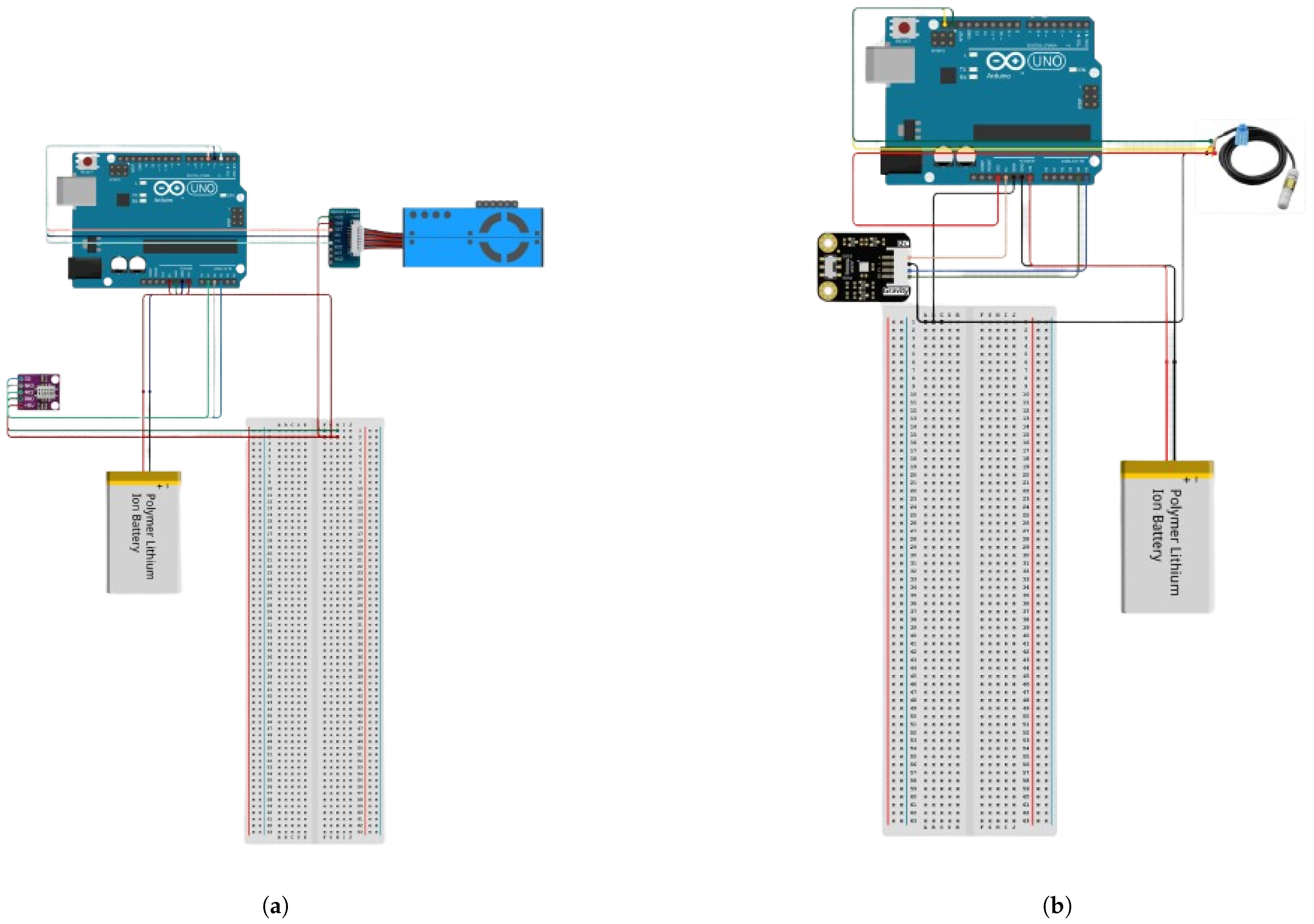
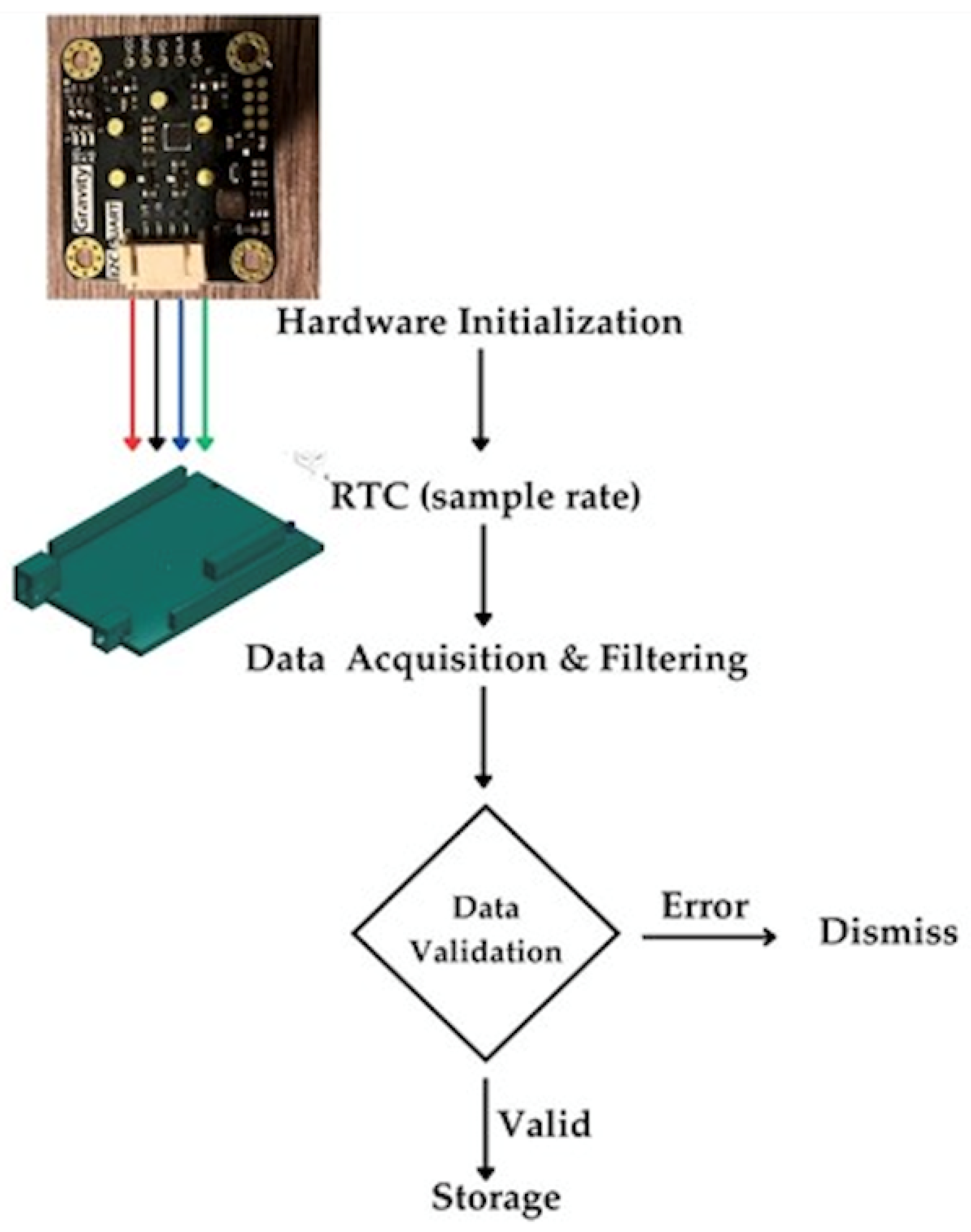

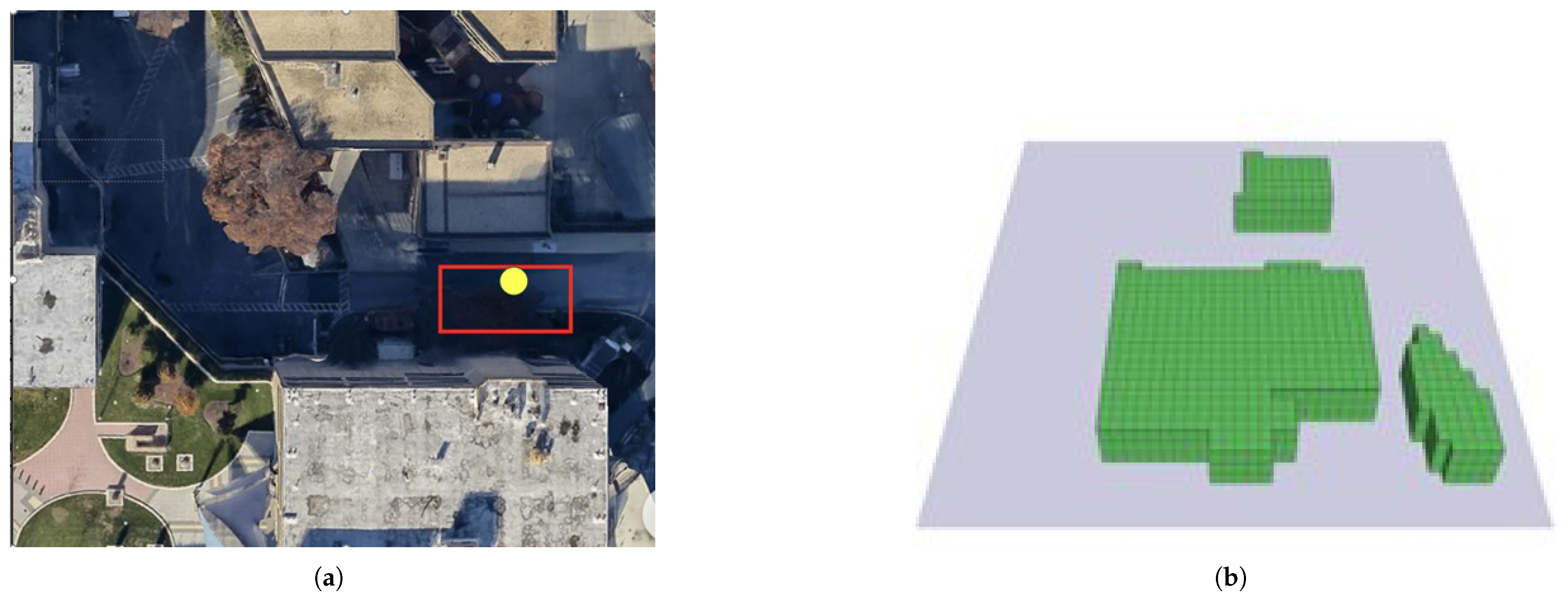
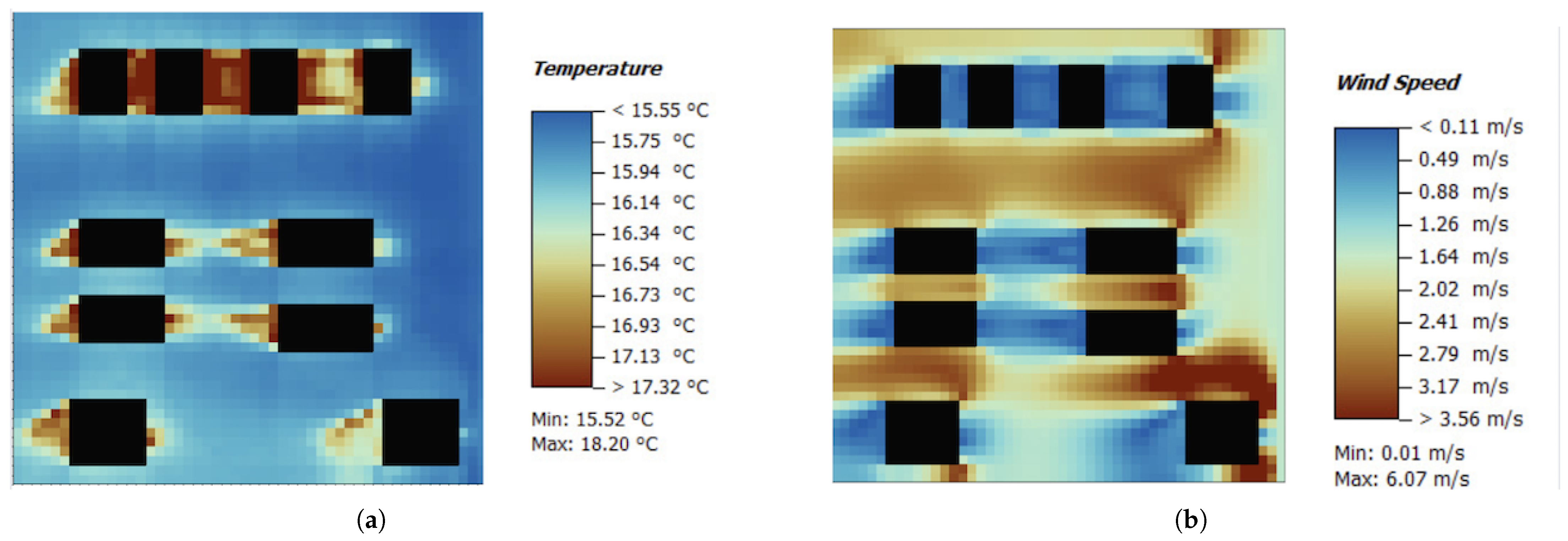
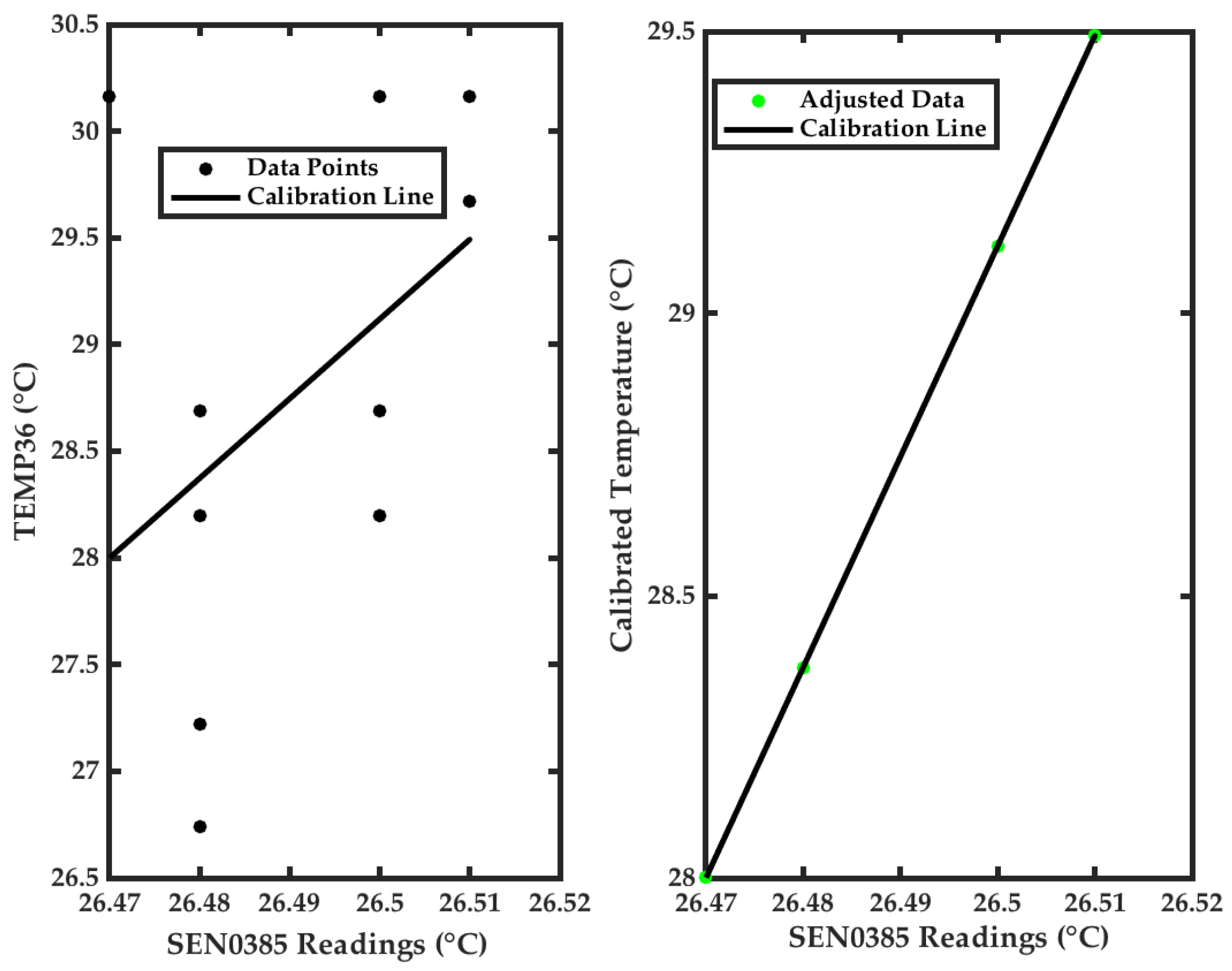
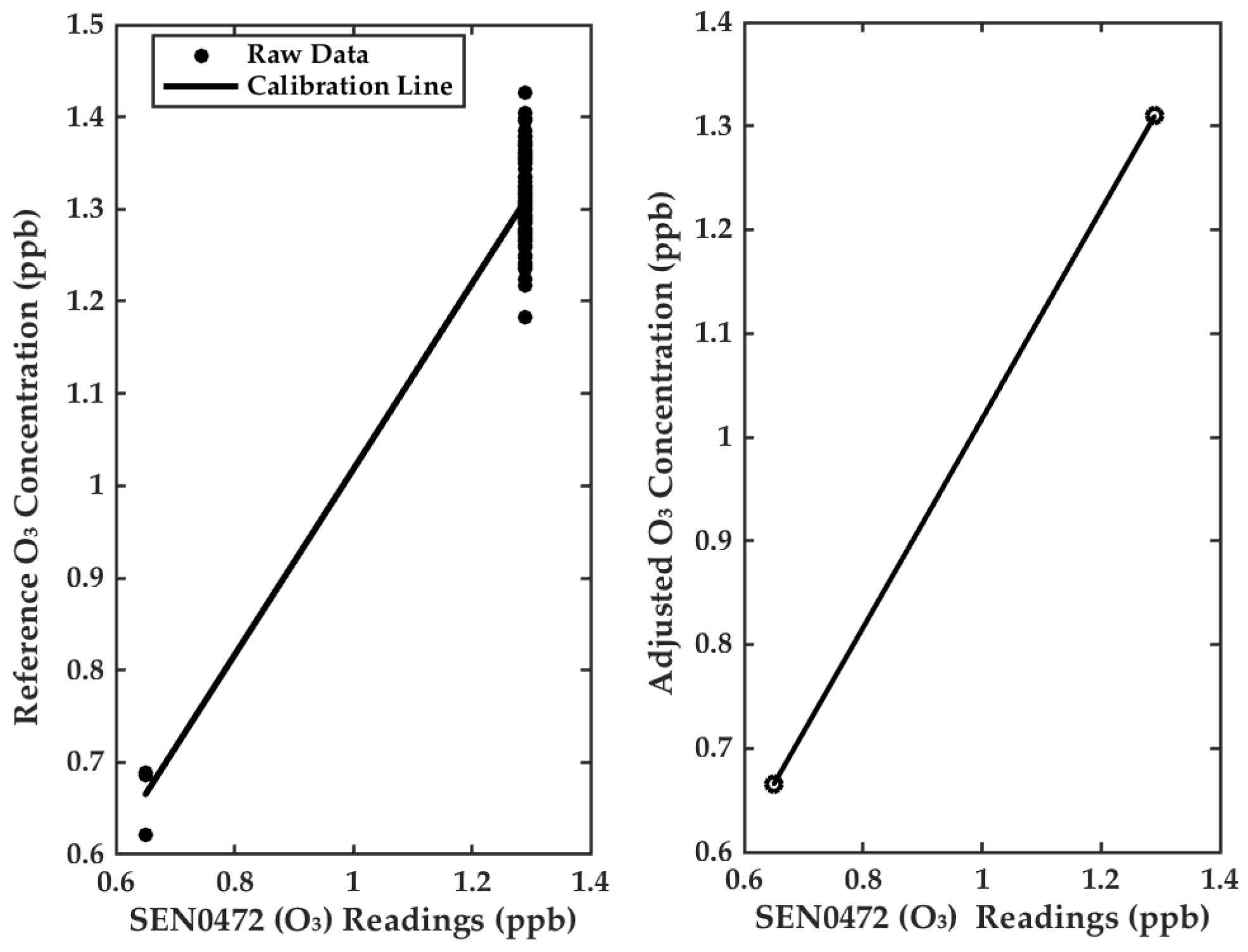

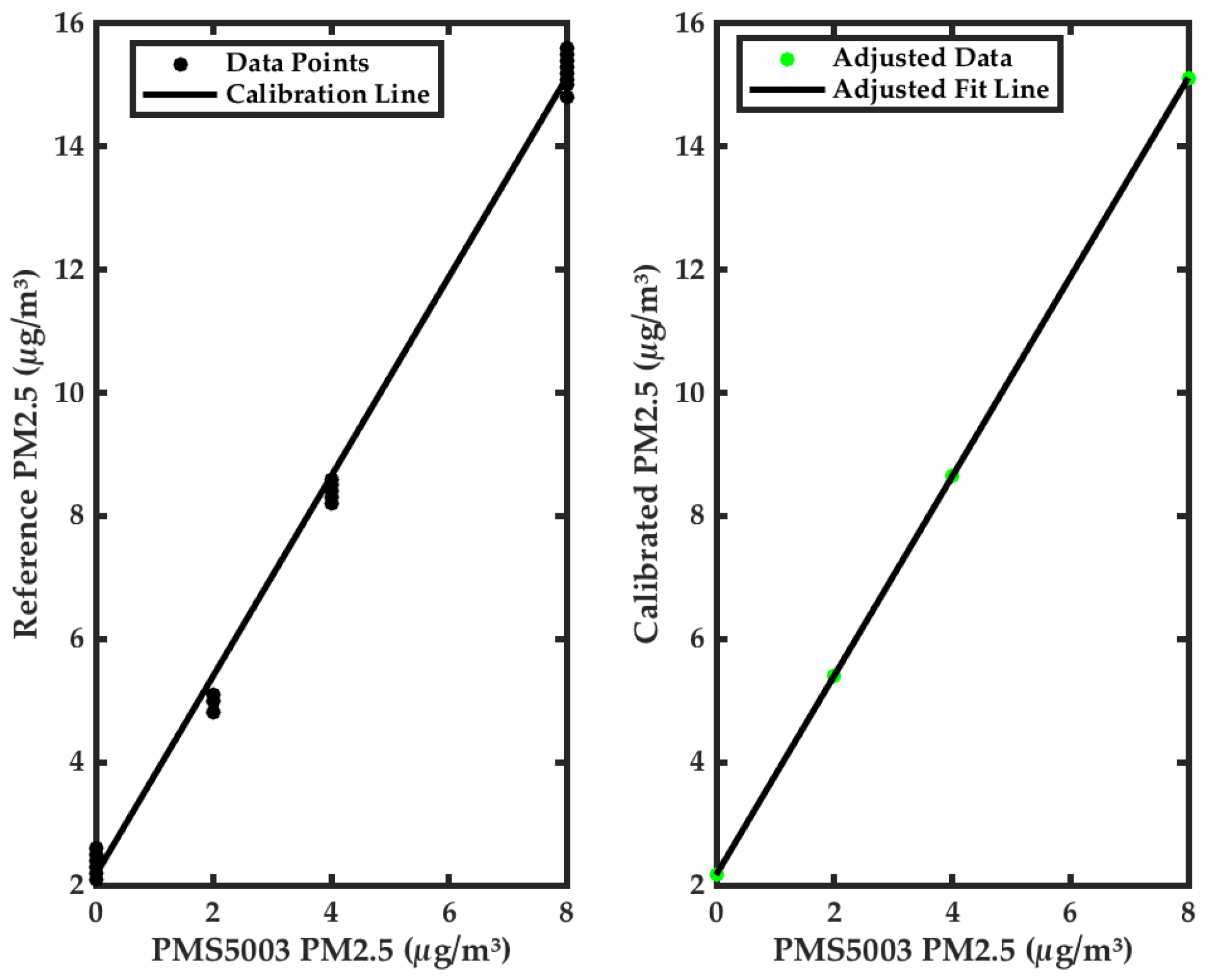
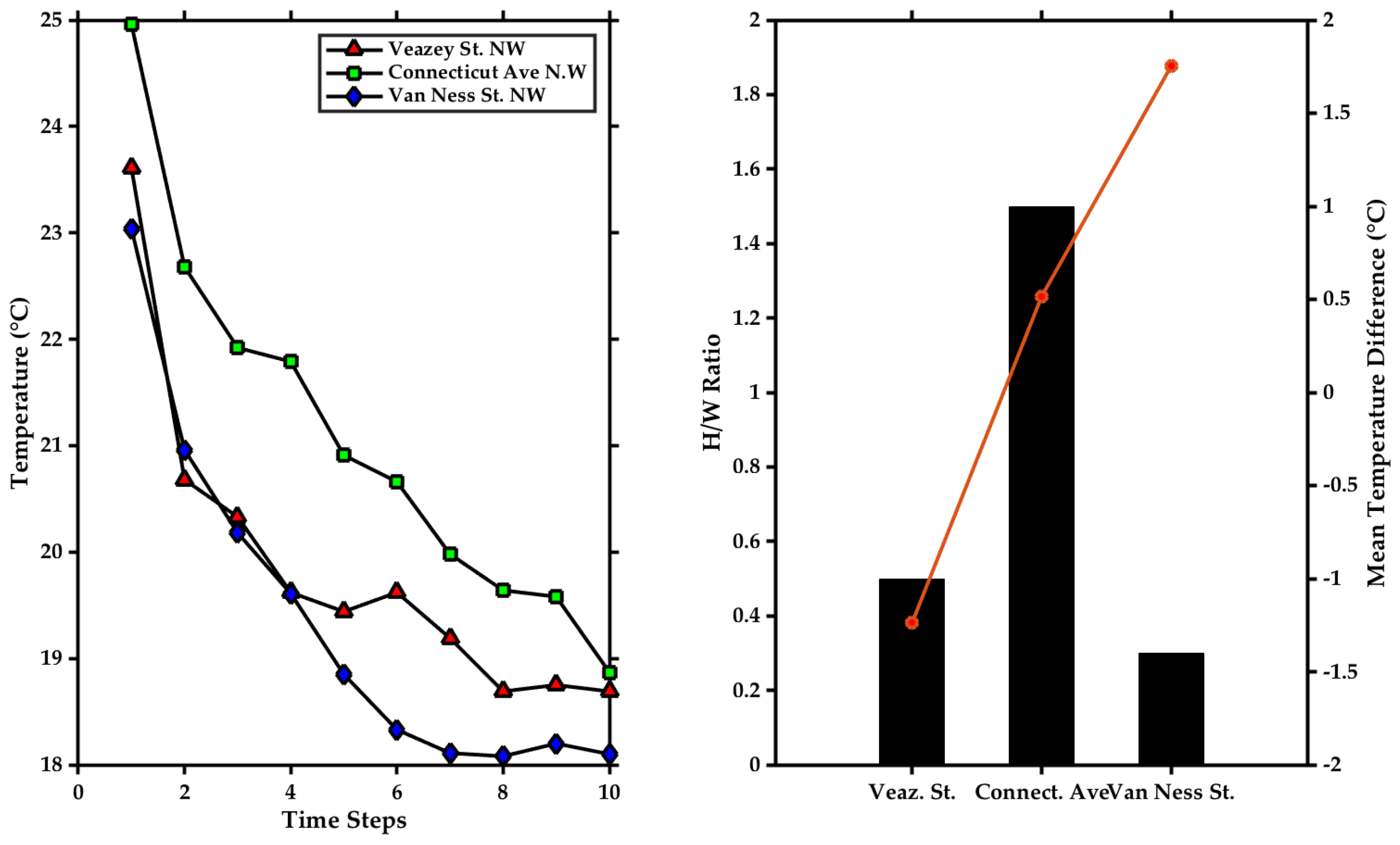
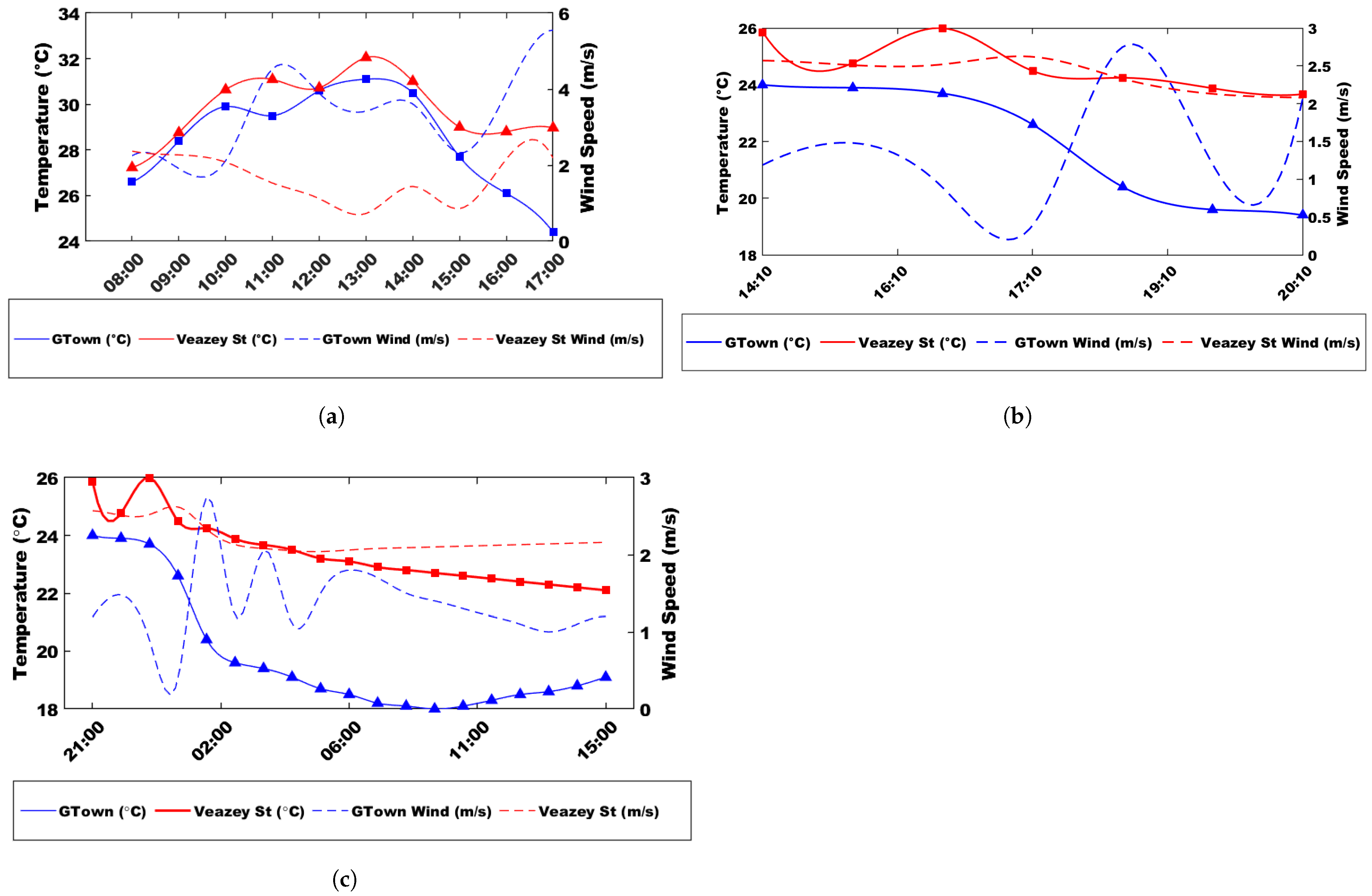


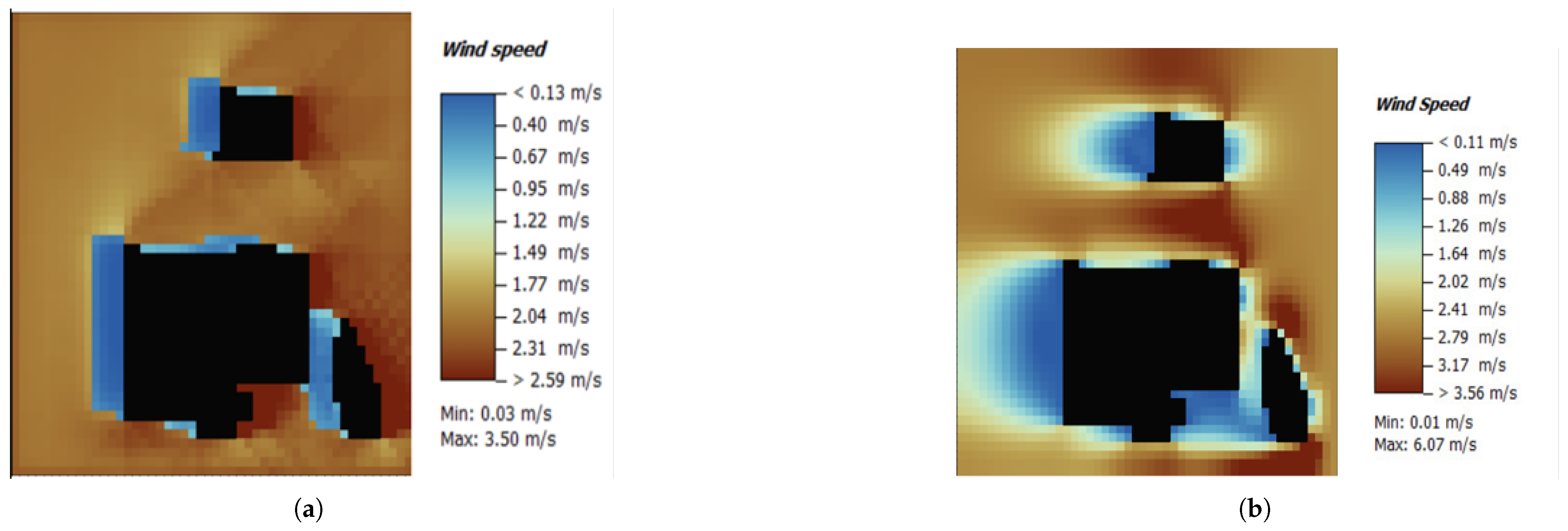


| Sensor 1 | Measured Parameters | Resolution | Accuracy |
|---|---|---|---|
| PMS5003 | PM1.0, PM2.5, PM10 | 0.1 µg/m³ | ±10% or ±1 µg/m³ |
| MICS 6814 (Gas Sensor) | CO, NO2, NH3 | 0.1 ppm | ±5% of reading or ±1 ppm |
| SEN0472 | O3 | 0.1 ppm | ±5% of reading or ±1 ppm |
| SEN0385 | Temperature, Humidity | 0.1 °C (Temp), 1% (Humidity) | ±0.3 °C (Temperature), ±3% (Humidity) |
| Ultrasonic Portable Solar Wind Instrument (Calypso) | Wind Speed, Wind Direction, Humidity | 0.1 m/s (Wind Speed) | ±2% (Wind Speed), ±3° (Wind Direction) |
| Location | Building Height (m) 2 | Street Width (m) 2 | H/W Ratio |
|---|---|---|---|
| Veazey St NW | 10–15 | 15–20 | 0.5–0.75 |
| Connecticut Ave NW | 20–30 | 10–15 | 1.5–2.0 |
| Van Ness St | 6–10 | 20–25 | 0.3–0.5 |
| Element | Property | Value |
|---|---|---|
| Walls (with moderate insulation) | Thermal Conductivity (W/m·K) | 0.35–0.45 |
| Density (kg/m3) | 600–900 | |
| Specific Heat (J/kg·K) | 1000–1200 | |
| Asphalt Roof | Thermal Conductivity (W/m·K) | 0.9–1.2 |
| Density (kg/m3) | 2200–2400 | |
| Specific Heat (J/kg·K) | 1000–1300 | |
| Roofing Tile | Thermal Conductivity (W/m·K) | 0.8–1.5 |
| Density (kg/m3) | 1400–1600 | |
| Specific Heat (J/kg·K) | 800–1000 | |
| Greenery (grass, typical vegetation) | Thermal Conductivity (W/m·K) | 0.2–0.5 |
| Density (kg/m3) | 50–400 | |
| Specific Heat (J/kg·K) | 1500–2000 |
| Parameter | Experimental Range | Simulated Range | RMSE | R2 |
|---|---|---|---|---|
| Air temperature (°C) 26 August | 30.38–32.29 | 30.12–32.10 | 0.75 | 0.91 |
| 6–7 November | 19.45 | 19.10–19.40 | 0.62 | 0.94 |
| Wind Speed (m/s) 26 August | 0.03–3.50 | 0.02–3.20 | 0.38 | 0.86 |
| 6–7 November | 0.04–4.50 | 0.03–4.10 | 0.42 | 0.88 |
Disclaimer/Publisher’s Note: The statements, opinions and data contained in all publications are solely those of the individual author(s) and contributor(s) and not of MDPI and/or the editor(s). MDPI and/or the editor(s) disclaim responsibility for any injury to people or property resulting from any ideas, methods, instructions or products referred to in the content. |
© 2025 by the authors. Licensee MDPI, Basel, Switzerland. This article is an open access article distributed under the terms and conditions of the Creative Commons Attribution (CC BY) license (https://creativecommons.org/licenses/by/4.0/).
Share and Cite
Mandjoupa, L.K.; Behera, P.; Roman, K.K.; Azam, H.; Denis, M. Street-Level Sensing for Assessing Urban Microclimate (UMC) and Urban Heat Island (UHI) Effects on Air Quality. Environments 2025, 12, 184. https://doi.org/10.3390/environments12060184
Mandjoupa LK, Behera P, Roman KK, Azam H, Denis M. Street-Level Sensing for Assessing Urban Microclimate (UMC) and Urban Heat Island (UHI) Effects on Air Quality. Environments. 2025; 12(6):184. https://doi.org/10.3390/environments12060184
Chicago/Turabian StyleMandjoupa, Lirane Kertesse, Pradeep Behera, Kibria K. Roman, Hossain Azam, and Max Denis. 2025. "Street-Level Sensing for Assessing Urban Microclimate (UMC) and Urban Heat Island (UHI) Effects on Air Quality" Environments 12, no. 6: 184. https://doi.org/10.3390/environments12060184
APA StyleMandjoupa, L. K., Behera, P., Roman, K. K., Azam, H., & Denis, M. (2025). Street-Level Sensing for Assessing Urban Microclimate (UMC) and Urban Heat Island (UHI) Effects on Air Quality. Environments, 12(6), 184. https://doi.org/10.3390/environments12060184






